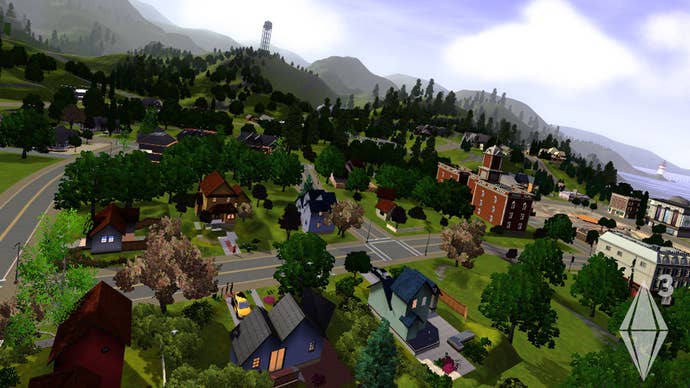The Sims 3 celebrates the 15th anniversary of its initial release today, and, as someone who excitedly took a fresh copy of the base game with them when they moved into their university halls of residence, allow me to take a break from booking myself in for a hip replacement to look back on one of the most lauded – yet divisive – entries into The Sims franchise.
As someone who has genuinely enjoyed every Sims game, I was a staunch TS3 apologist for most of its run; which is why its reassessment by the fandom as a strong contender for the best entry in the franchise has always felt jarring to me — and, if we’re being honest, caused me to become something of a devil’s advocate on the subject.
If you think The Sims 4 is disliked, rest assured that its immediate predecessor received almost like-for-like criticism while it was the in thing. You could argue that the shortcomings of TS4 have caused TS3 to be vindicated in hindsight, but it’s just as easy to argue that rosy nostalgia kicks in once there’s a fresh new upstart to pick apart. Realistically, as in most things, the truth probably lies somewhere in the middle.
Writing an anniversary retrospective on a game that’s not really gone away is an odd task. The Sims 3 ceremonially wrapped up in October 2013 with its 11th and final expansion pack, Into the Future; but frequent micro-additions via The Sims 3 Store continued until at least mid-2014. It’s surprisingly hard to get a firm idea of when exactly new content stopped coming to the store, but the general consensus seems to be that the true final release in this generation of the franchise was the aptly named Last Venue of Amore set from August 2014, less than a month before The Sims 4’s release.
Although EA/Maxis no longer particularly advertise their ongoing support for The Sims 3, it hasn’t fallen to the wayside as abandonware like the first two games in the franchise, either. Daily Deals and other regular offer rotations are available on The Sims 3 Store to this day, and all of the expansions – plus most stuff packs – can still be purchased via the EA App and Steam. The only content for The Sims 3 that’s ever been more than a legitimate purchase away are certain brand tie-ins whose licences have expired in the intervening decade, which amounts to a handful of store items and, most notably, the Katy Perry-fronted stuff pack from 2012.
It’s similarly hard to get a firm idea of just which Sims game is the best-selling, with factors like paid add-ons sometimes being counted as separate sales (but just as often not) and The Sims 4 base game going free-to-play in 2022 making actual player numbers hard to pin down. But what seems fairly certain is that The Sims 3 was never a contender for the top seller in the series — although with all that store content totting up to about $75K in total, it’s easily the most expensive entry for completionists, no matter how many $5 kits get added to The Sims 4.

While you’d have to really stretch your imagination to call The Sims 4 a commercial failure, it’s hard to ignore that it’s not quite hit the standards of the previous entries into the franchise when it comes to being a darling with critics and players. And sure, TS3’s popularity required a hefty dose of hindsight: during its tenure as the current gen, Sims discussion boards lit up with unfavourable comparisons to The Sims 2 on a daily basis, because history loves to repeat itself.
But even if you can write off at least some of the anti-TS4 sentiment in the fandom right now as the result of rosy retrospection, mixed with maybe just a pinch of exhaustion as the game stretches into its 10th year (double the time any of its forebears went without receiving a sequel), you can’t get away from the fact that The Sims 4 is in many ways a simpler game than its predecessor. The goal was to avoid the severe performance issues that rendered late-gen TS3 nigh-on unplayable even if you owned some sort of NASA supercomputer — not out of a sense of consumer-oriented altruism, but because EA figured out that the average Sims player was on a fairly low-end laptop that simply couldn’t keep up with a game that could barely keep up with itself.
But jettisoning popular features like the colour wheel — which allowed almost every object, item of clothing, and genetic trait to be customised by the player — and the open world to achieve this smoother running was always going to ensure The Sims 4 suffered when it came to comparing the two.

So when we see upcoming Sims competitors Life by You, Paralives, and inZOI all obviously taking The Sims 3 as their main inspiration — complete with promises of open worlds, deep-level customisation options, and high-end graphics — we have to assume it’s that exact player nostalgia that they’re banking on. Throw in a dash of up-front transparency about the eye-watering system specs required for some of those spiritual follow-ups, and you can see that the hope is to capture an audience looking back on the Sims game they were most excited for but perhaps never really got to play.
And with Project Rene (a.k.a. The Sims 5) seemingly eager to figure out the secret sauce that allowed Animal Crossing: New Horizons to eat TS4’s lunch as the lockdown social sim of choice, rather than to revisit the mourned-for highlights of its own franchise’s third entry, you can see how this might work out very well indeed for the new kids on the block.

But my breakdown of The Sims 3 Store content earlier wasn’t just introductory flavour, because that’s also a huge part of the legacy of The Sims 3: every much as influential to the future of the life sim genre as the open world and the deep-level customisation on offer. TS3 was the first generation of the franchise to be released digitally as well as physically; and was the first to require an internet connection to verify your installation, rather than just suggesting it’d be a nice thing to do if you could.
Being always (or at least frequently) online meant that The Sims 3 could introduce things like hotfix patches to address known issues, something that The Sims and The Sims 2 usually just left until the next expansion release to fix, and isn’t that wild in hindsight? You had to buy a new full-price add-on if you wanted a solution to the bugs in the last product you paid full price for! Whatever your views on the increasing digitisation of modern gaming, you have to admit that at least you’re far less likely to buy a broken game that just…stays broken, even if the other side of the coin is that there’s maybe less incentive to release a thoroughly polished product on launch day.
But of course, that required connection also meant that The Sims 3 could introduce impulse-buy microtransactions in a big way, and since we know full well that EA is always down for a new aggressive monetisation strategy, it’s no shock that it went all-out. It’s not just the whopping cost of a complete Sims 3 collection, it’s the way it was incorporated into the game.
The Sims 4 has recently caught some flack for pushing unowned DLC content on players in-game instead of keeping its sales pitches to the landing page, and that annoying problem is recycled straight from The Sims 3. Later in its lifecycle, TS3 even took advantage of its own glacial load times (a fully-expanded game could take up to an hour to load a save even on a PC that technically met the system requirements, thanks to the vast number of moving parts in the open world) to introduce a hidden-object mini-game on the load screen that none-too-subtly showcased items purchasable from the store.

The precise influence of these choices on the future of the life sim genre remains to be seen. DLC add-ons are basically a given at this point, but the indie devs in the Paralives team have already vowed that all of their content updates will be made available to players for free. There’s been no official word on add-on content for either Life by You or inZOI; but with Paradox known for DLC practices that sometimes eclipse even EA’s, and Krafton’s history being deeply enmeshed with the development of the now-ubiquitous battle pass model, it’s plausible that both studios are already at home with the idea that the monetisation strategies they’re familiar with will translate well into the life sim market.
And, it goes without saying, when it comes to Project Rene, EA doesn’t intend to fix what isn’t broken (at least from a revenue perspective), with The Sims 5 likely taking the form of an F2P base game regularly supplemented by a mixture of paid and unpaid updates.
While The Sims 3 didn’t originate the idea of the massively-expanded life sim, it did provide the first test case of which DLC practises life sim developers could get away with in a digital marketplace. Just as it pared back to avoid the worst of its predecessor’s technical issues, The Sims 4 shrunk away from the worst excesses of The Sims 3 Store, only to reintroduce most of them slowly over time. And, fairly or not, in the court of player opinion it seems like The Sims 4 is doomed to go down in history as a more unforgivable shill than the game which actually introduced microtransactions to the series in the first place.

If there’s one thing The Sims 3 undeniably does best, it all comes back to that nostalgia. I’m beginning to doubt that hindsight will be as kind to The Sims 4 in a few years’ time as it has been to The Sims 3, which introduced some game-changing ideas before the hardware was really there to support them, but is now looked back on fondly for at least pushing the franchise into bold new territories.
The Sims 4 has brought in some fun new ideas over the past decade; it contains many pleasing iterations on the core Simsyness that unites the entire series; and even if it’s far from perfect, take it from someone who’s poured thousands of hours into this franchise over the course of nearly a quarter of a century when I say it runs, at the very least, better than anything that came before it. But it doesn’t have its equivalent to the open world: a big set piece that maybe didn’t really work all that well in practice, but that everyone loved as an idea for bringing the life sim to the next level.
Thanks to The Sims 3, it feels like a given that the next truly great life sim, the one that finally creates a new benchmark for the genre, will be a deeply customisable open world experience. This seems obvious to everyone — except, somehow, for the studio that laid out all of the building blocks needed for the genre’s next big triumph.

